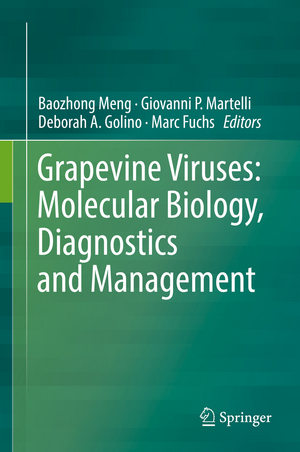Grapevine Viruses: Molecular Biology, Diagnostics and Management
Editat de Baozhong Meng, Giovanni P. Martelli, Deborah A. Golino, Marc Fuchsen Limba Engleză Hardback – 18 iul 2017
cline and red blotch can result in total crop loss several years post-infection. This situation is further exacerbated by mixed infections with multiple viruses and other biotic as well as adverse abiotic environmental conditions, such as drought and winter damage, causing even greater destruction.The book builds upon the last handbook (written over twenty years ago) on the part of diagnostics and extensively expands its scope by inclusion of molecular biology aspects of select viruses that are widespread and economically most important. This includes most current information on the biology, transmission, genome replication, transcription, subcellular localization, as well as virus-host interactions. It also touches on several novel areas of scientific inquiry. It also contains suggested directions for future research in the field of grapevine virology.
| Toate formatele și edițiile | Preț | Express |
|---|---|---|
| Paperback (1) | 1731.35 lei 38-44 zile | |
| Springer International Publishing – 12 aug 2018 | 1731.35 lei 38-44 zile | |
| Hardback (1) | 1745.19 lei 38-44 zile | |
| Springer International Publishing – 18 iul 2017 | 1745.19 lei 38-44 zile |
Preț: 1745.19 lei
Preț vechi: 2296.31 lei
-24% Nou
Puncte Express: 2618
Preț estimativ în valută:
333.95€ • 349.54$ • 277.95£
333.95€ • 349.54$ • 277.95£
Carte tipărită la comandă
Livrare economică 26 martie-01 aprilie
Preluare comenzi: 021 569.72.76
Specificații
ISBN-13: 9783319577043
ISBN-10: 3319577042
Pagini: 731
Ilustrații: XI, 698 p. 92 illus., 76 illus. in color.
Dimensiuni: 155 x 235 mm
Greutate: 1.32 kg
Ediția:1st ed. 2017
Editura: Springer International Publishing
Colecția Springer
Locul publicării:Cham, Switzerland
ISBN-10: 3319577042
Pagini: 731
Ilustrații: XI, 698 p. 92 illus., 76 illus. in color.
Dimensiuni: 155 x 235 mm
Greutate: 1.32 kg
Ediția:1st ed. 2017
Editura: Springer International Publishing
Colecția Springer
Locul publicării:Cham, Switzerland
Cuprins
SECTION I: An overview on grapevine viruses, viroids and the diseases they cause.- 1. The grapevine, viticulture and wine making - a brief introduction.- 2. An overview on grapevine viruses, viroids and the diseases they cause.- 3. Grapevine fanleaf virus and other old world nepoviruses.- 4. Molecular, cellular and structural biology of Grapevine fanleaf virus.- 5. American nepoviruses. 6. Grapevine leafroll-associated virus 1.- 7. Grapevine leafroll-asscoiated virus 2.- 8. Grapevine leafroll-associated virus .- 9. Grapevine leafroll-associated virus 4.- 10. Grapevine leafroll-associated virus 7.- 11. Grapevine vitiviruses.- 12. Grapevine rupestris stem pitting-associated virus. .- 13. Viruses involved in graft-incompatibility and decline. 14. Grapevine red blotch: molecular biology of the virus and management of the disease.- 15. Grapevine vein clearing virus: diagnostics, genome, genetic diversity and manag
ement.- 16. Grapevine fleck and similar viruses.- 17: Grapevine Pinot gris virus.- 18. Other grapevine viruses of lesser economic importance.- 19. Viroids infecting the grapevine.- SECTION II: Methods for Diagnostics.- 20. Biological assays 21. Serological methods for the detection of major grapevine viruses.- 22. Polymerase chain reaction methods for the detection of grapevine viruses and viroids.- SECTION III: Effects of viral diseases, epidemiology and strategies for the control and management of viruses and viral diseases.- 23. The effects of viruses and viral diseases on grapes and wine.- 24. Vector transmission of grapevine leafroll-associated viruses.- 25. Ectoparasitic nematode vectors of grapevine viruses.- 26. Management of Grapevine Leafroll Disease and Associated Vectors in Vineyards.- 27. Improvement of grapevine planting stock through sanitary selection and pathogen elimination.- 28. Regulatory aspects of grape viruses and virusdiseases: certification, quarantine and harmonization.- 29. Novel approaches for viral disease management.- SECTION IV: Evolution and biotechnological applications of grapevine viruses.- 30. High-throughput sequencing: advantages beyond virus identification.- 31. Biotechnology applications of grapevine viruses.- 32. Evolutionary aspects of grapevine virology.- 33. Concluding remarks and future directions. G. P. Martelli.
ement.- 16. Grapevine fleck and similar viruses.- 17: Grapevine Pinot gris virus.- 18. Other grapevine viruses of lesser economic importance.- 19. Viroids infecting the grapevine.- SECTION II: Methods for Diagnostics.- 20. Biological assays 21. Serological methods for the detection of major grapevine viruses.- 22. Polymerase chain reaction methods for the detection of grapevine viruses and viroids.- SECTION III: Effects of viral diseases, epidemiology and strategies for the control and management of viruses and viral diseases.- 23. The effects of viruses and viral diseases on grapes and wine.- 24. Vector transmission of grapevine leafroll-associated viruses.- 25. Ectoparasitic nematode vectors of grapevine viruses.- 26. Management of Grapevine Leafroll Disease and Associated Vectors in Vineyards.- 27. Improvement of grapevine planting stock through sanitary selection and pathogen elimination.- 28. Regulatory aspects of grape viruses and virusdiseases: certification, quarantine and harmonization.- 29. Novel approaches for viral disease management.- SECTION IV: Evolution and biotechnological applications of grapevine viruses.- 30. High-throughput sequencing: advantages beyond virus identification.- 31. Biotechnology applications of grapevine viruses.- 32. Evolutionary aspects of grapevine virology.- 33. Concluding remarks and future directions. G. P. Martelli.
Notă biografică
Assoc.Prof. Baozhong Meng, University of Guelph, College of Biological Science, Guelph N1G 2W1, Canada
Prof. Giovanni P. Martelli, Universita Degli Studi Di Bari, Dipt. Protezione Delle Piante Dalle, 70121 Bari, Italy
Prof. Deborah A. Golino, University of California, Foundation Plant Services, Davis, CA 95616-8751, USA
Assoc.Prof. Marc Fuchs, Department of Plant Pathology, and Plant-Microbe Interactions, Cornell University, Ithaca,
NY 14853-5905, USA
Textul de pe ultima copertă
The domestication of grapes dates back five thousand years ago and has spread to nearly all continents. In recent years, grape acreage has increased dramatically in new regions, including the United States of America, Chile, Asia (China and India), and Turkey. A major limiting factor to the sustained production of premium grapes and wines is infections by viruses. The advent of powerful molecular and metagenomics technologies, such as molecular cloning and next generation sequencing, allowed the discovery of new viruses from grapes. To date, grapevine is susceptible to 64 viruses that belong to highly diverse taxonomic groups. The most damaging diseases include: (1) infectious degeneration; (2) leafroll disease complex; and (3) rugose wood complex. Recently, two new disease syndromes have been recognized: Syrah decline and red blotch. Losses due to fanleaf degeneration are estimated at $1 billion annually in France alone. Other diseases including leafroll, rugose wood, Syrah de
cline and red blotch can result in total crop loss several years post-infection. This situation is further exacerbated by mixed infections with multiple viruses and other biotic as well as adverse abiotic environmental conditions, such as drought and winter damage, causing even greater destruction. The book builds upon the last handbook (written over twenty years ago) on the part of diagnostics and extensively expands its scope by inclusion of molecular biology aspects of select viruses that are widespread and economically most important. This includes most current information on the biology, transmission, genome replication, transcription, subcellular localization, as well as virus-host interactions. It also touches on several novel areas of scientific inquiry. It also contains suggested directions for future research in the field of graThe domestication of grapes dates back five thousand years ago and has spread to nearly all continents. In recent yea
rs, grape acreage has increased dramatically in new regions, including the United States of America, Chile, Asia (China and India), and Turkey. A major limiting factor to the sustained production of premium grapes and wines is infections by viruses. The advent of powerful molecular and metagenomics technologies, such as molecular cloning and next generation sequencing, allowed the discovery of new viruses from grapes. To date, grapevine is susceptible to 64 viruses that belong to highly diverse taxonomic groups. The most damaging diseases include: (1) infectious degeneration; (2) leafroll disease complex; and (3) rugose wood complex. Recently, two new disease syndromes have been recognized: Syrah decline and red blotch. Losses due to fanleaf degeneration are estimated at $1 billion annually in France alone. Other diseases including leafroll, rugose wood, Syrah decline and red blotch can result in total crop loss several years post-infection. This situation is further exacerbated by mixed infections with multiple viruses and other biotic as well as adverse abiotic environmental conditions, such as drought and winter damage, causing even greater destruction. The book builds upon the last handbook (written over twenty years ago) on the part of diagnostics and extensively expands its scope by inclusion of molecular biology aspects of select viruses that are widespread and economically most important. This includes most current information on the biology, transmission, genome replication, transcription, subcellular localization, as well as virus-host interactions. It also touches on several novel areas of scientific inquiry. It also contains suggested directions for future research in the field of grapevine virology.pevine virology.
cline and red blotch can result in total crop loss several years post-infection. This situation is further exacerbated by mixed infections with multiple viruses and other biotic as well as adverse abiotic environmental conditions, such as drought and winter damage, causing even greater destruction. The book builds upon the last handbook (written over twenty years ago) on the part of diagnostics and extensively expands its scope by inclusion of molecular biology aspects of select viruses that are widespread and economically most important. This includes most current information on the biology, transmission, genome replication, transcription, subcellular localization, as well as virus-host interactions. It also touches on several novel areas of scientific inquiry. It also contains suggested directions for future research in the field of graThe domestication of grapes dates back five thousand years ago and has spread to nearly all continents. In recent yea
rs, grape acreage has increased dramatically in new regions, including the United States of America, Chile, Asia (China and India), and Turkey. A major limiting factor to the sustained production of premium grapes and wines is infections by viruses. The advent of powerful molecular and metagenomics technologies, such as molecular cloning and next generation sequencing, allowed the discovery of new viruses from grapes. To date, grapevine is susceptible to 64 viruses that belong to highly diverse taxonomic groups. The most damaging diseases include: (1) infectious degeneration; (2) leafroll disease complex; and (3) rugose wood complex. Recently, two new disease syndromes have been recognized: Syrah decline and red blotch. Losses due to fanleaf degeneration are estimated at $1 billion annually in France alone. Other diseases including leafroll, rugose wood, Syrah decline and red blotch can result in total crop loss several years post-infection. This situation is further exacerbated by mixed infections with multiple viruses and other biotic as well as adverse abiotic environmental conditions, such as drought and winter damage, causing even greater destruction. The book builds upon the last handbook (written over twenty years ago) on the part of diagnostics and extensively expands its scope by inclusion of molecular biology aspects of select viruses that are widespread and economically most important. This includes most current information on the biology, transmission, genome replication, transcription, subcellular localization, as well as virus-host interactions. It also touches on several novel areas of scientific inquiry. It also contains suggested directions for future research in the field of grapevine virology.pevine virology.
Caracteristici
High readability of the text, logical presentation, careful choice of language, and inclusion of color pictures on symptoms exhibited by infections and diseases caused by different viruses The book is comprehensive and contains all aspects of grapevine virology and most up to date information The editorial team comprises of leading scientists in the field. Each of the chapters is written by leading experts on the specific subject area in question There are no competitive books in this scale that is currently available. This is the first edition of a quality and comprehensive book that will be made available on grape viruses and their diseases, diagnostics, virus transmission as well as control and management measures








